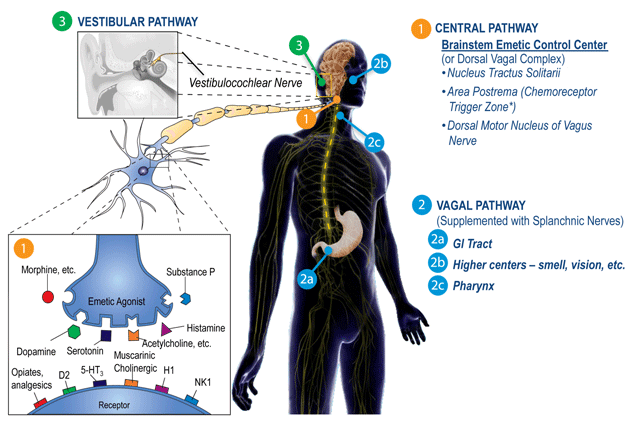Palliative Care
Mechanism of nausea and vomiting
Nausea is the feeling of the need to vomit, whereas vomiting is the expulsion of stomach contents through the mouth. It affects up to 70% of patients with cancer as well as people with AIDs, liver and renal failure and is particular distressing to patients if it persists for prolonged periods.
The vomiting centre (VC) is the control centre and possesses the ultimate decision on the vomiting response. It consists of a series of interconnected nuclei located in the medulla oblongata of the brainstem and is within the blood brain barrier.
The VC receives signals from the chemoreceptor trigger zone (CTZ), cerebral cortex, peripheral vagal and sympathetic nerves of the GI tract, and the vestibular apparatus. This result in the stimulation of the motor pathways where muscles involved in emesis is activated.
CTZ
The CTZ is located in the area postrema of the fourth ventricle in the brain stem, it is susceptible to toxins and emetogenic substances as it lies outiside the blood brain barrier. It forms part of the dorsal vagal complex which consists of the the nucleus solitar tract and dorsal motor nucleus which plays a major role as a relay station for vagal afferents to the VC.
The vestibular system
The vestibulococholear nerve in the labyrinth of the ear detects changes in position and mediates such information to the vestibular apparatus which in turn relay impulses to the VC.
The vagal nerve
The vagal nerve forms the major afferent neural pathway relaying information from the body to the VC and can be stimulated by chemoreceptors and mechanoreceptors present in the GI tract i.e intestine and pharynx.
Higher centres
Centres such as the cerebral cortex detect sensory stimulus i.e smell, taste, memory and pain which subsequently stimulates the VC.
Motor pathways extend from the vomiting centre to the following effectors:
-
upper GI tract via cranial nerves 5,7,9,10 and 12
-
lower GI tract through vagal and sympathetic nerves
-
contraction of abdominal muscles and the diaphragm through the spinal nerves.
-
Activation of the above effectors produces emesis
